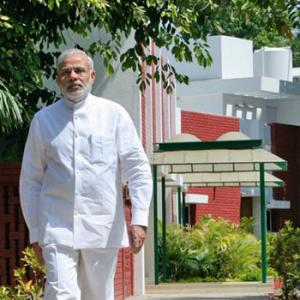 Adani Enterprises, the Adani Group flagship, has been one of the biggest gainers of the ‘Modi-fied’ rally on bourses. The stock has more than doubled since the beginning of this year. At its Friday closing price, the company is valued at around Rs 48,000 crore (Rs 480 billion) against Rs 28,000 crore ( Rs 280 billion) at the beginning of the year and Rs 15,500 crore (Rs 155 billion) at the end of September last year.
Adani Enterprises, the Adani Group flagship, has been one of the biggest gainers of the ‘Modi-fied’ rally on bourses. The stock has more than doubled since the beginning of this year. At its Friday closing price, the company is valued at around Rs 48,000 crore (Rs 480 billion) against Rs 28,000 crore ( Rs 280 billion) at the beginning of the year and Rs 15,500 crore (Rs 155 billion) at the end of September last year.
The spike in the company’s valuation is, however, not justified by any apparent improvement in its finances.
The company continues to suffer from cash flow mismatch, due to a mix of ambitious capital expenditure (capex) commitments and losses at Adani Power, a subsidiary in which the group flagship holds 75 per cent stake.
Its other subsidiary, Adani Ports & SEZ, where it holds 69 per cent stake remains profitable and growing but its cash flows fall short of capex. Both subsidiaries are listed separately and their numbers reflect in Adani Enterprises’ consolidated finance.
This has resulted in a high leverage and poor interest coverage ratio for Adani Enterprises. Interest coverage (ratio of operating profit to interest payment) declined to two in the December 2013 quarter from 2.6 at the end of March, though it was up on a sequential basis.
At the end of the September 2013 quarter, the company had total debt of around Rs 80,000 crore on a consolidated basis, translating into a debt to equity ratio of around 3.5. Of this, Rs 70,600 crore ( Rs 706 billion) are loan funds (or borrowings) and the balance is deferred taxes and other liabilities.
A bulk of this debt is accounted by Adani Power (around Rs 42,000 crore or Rs 420 billion at the end of FY13) followed by Adani Port (Rs 12,000 crore or Rs 120 billion).
“Adani Enterprises is one of the popular high-beta stocks and highly reactive to market movements. It rises faster than the overall market (benchmark indices) but falls equally hard when sentiment turns negative,” says Devang Mehta, senior vice-president and head, equity at Anand Rathi Financial Services.
On the brighter side, the recent spike in the holding company was preceded by a rally in Adani Ports and Adani Power. The former is up nearly 30 per cent from the beginning of the year and is currently valued at around Rs 40,000 crore ( Rs 400 billion). Adani Power has nearly doubled in market value during the period to around Rs 16,000 crore ( Rs 160 billion).
This has opened the possibility of the group monetising a part of its investment in either company. “There is likelihood of the group raising money by offering a minority stake to foreign investors in some its port and mining assets. This will help it to reduce its debt and improve valuations,” says Dhananjay Sinha, head, institutional equity, at Emkay Global Financial Services. This will, however, require a break on the group’s ambitious growth plans in ports, coal mining and power sectors.
The immediate challenge for the group is to turn around its power venture that reported losses of Rs 426 crore ( Rs 4.26 billion)in the December quarter and saw erosion in its net worth. Besides, it needs funds to the tune of $10 billion over the next four years to start work on the Carmichael coal project in Australia.
The group, however, crossed two important milestones recently. Its Mundra port (owned by Adani Ports & SEZ) crossed 100 million tonnes per year cargo handling capacity — making it one of the biggest ports in the country. Adani Power became India’s biggest private sector power producer, surpassing Tata Power by producing 8,620 Mw. The company will add another 660 Mw by June this year.
Analysts say the Australian project is crucial for the group, as it has already invested $2 billion to develop the coal mine and create infrastructure for exports. But analysts are sceptical saying it is “unviable” to extract coal from interior Australia and then ship it to Asia, as there will not be any buyer for this price.
The group’s high leverage is another worry. To soothe the concerns of investors, Adani Ports transferred the Australian port project to the Adani family last year at a book value of $211 million. This was after analysts raised objections over the project’s huge debt of nearly $2 billion.
The Institute for Energy Economics and Financial Analysis warns that the group has suffered a series of delays to its Australian mining, rail and port plans. After the initial plan to start selling coal by 2014, this timetable has been now pushed to 2016. “But we think 2017 at the earliest is more likely, with full production beyond 2022. Any delays would continue to squeeze the Adani Group’s cash flow,” the institute says.
It says India’s power market cannot absorb the high price of coal from the Australian project. One objective of the project is to supply thermal coal coast based thermal plants in India, including the Adani Power Mundra project.
The domestic price of coal is around $30 a tonne. Landed cost of Carmichael coal, as and when it will be developed, would be around $95 a tonne, inclusive of shipping. “Successful sales to India of Carmichael coal will place a substantial pressure on the power generator’s profits and the price of electricity in India. We see this as a flawed strategy, given conflicting currency, fiscal and balance of trade dynamics in India,” analyst Tim Buckley said.
Ambitious targets
Adani Enterprises plans to invest a total of $25 billion in the next five years. It plans to commission four new coal mines in India with a peak capacity of 110 mtpa from almost zero in 2012-13 and triple its Indonesian coal production and build the new 60 mtpa Carmichael project — the biggest coal project in Australian history.
At Adani Ports, the group has three ports in operation, with plans to commission another three at Mormugao, Visakhapatnam and Kandla over the next three years — giving it a national footprint. The group is also in talks to take over Dhamra port in Odisha from L&T and Tata Steel. By 2020, it wants to produce 20,000 Mw of power and increase its port handling capacity to 200 mtpa.










